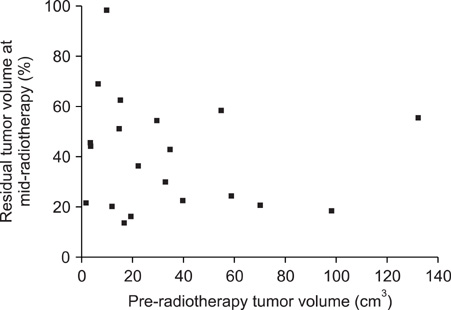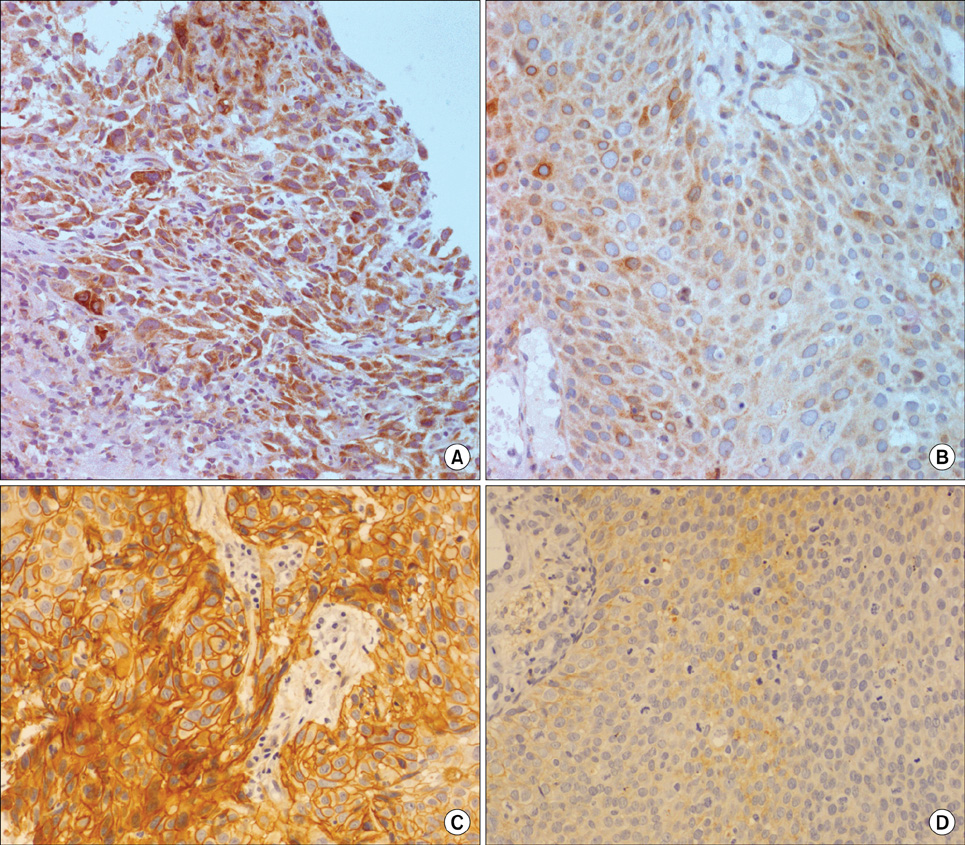J Gynecol Oncol.
2009 Dec;20(4):215-220. 10.3802/jgo.2009.20.4.215.
Correlation between tumor volume response to radiotherapy and expression of biological markers in patients with cervical squamous cell carcinoma
- Affiliations
-
- 1Department of Radiation Oncology, Samsung Medical Center, Sungkyunkwan University School of Medicine, Seoul, Korea. wonro.park@samsung.com
- 2Department of Pathology, Samsung Medical Center, Sungkyunkwan University School of Medicine, Seoul, Korea.
- 3Department of Obstetrics and Gynecology, Samsung Medical Center, Sungkyunkwan University School of Medicine, Seoul, Korea.
- KMID: 2288585
- DOI: http://doi.org/10.3802/jgo.2009.20.4.215
Abstract
OBJECTIVE
To determine the factors associated with tumor volume response to radiotherapy (RT) in cervical cancer patients, and the relationship between the tumor volume response and alteration of the expression of biological markers during RT.
METHODS
Twenty consecutive patients with cervical squamous cell carcinoma who received definitive RT were enrolled. Tumor volumes were calculated by MRI examinations performed at the start of RT (pre-RT), at the fourth week of RT (mid-RT), and 1 month after RT completion (post-RT). Two serial punch biopsies were performed at pre- and mid-RT, and immunohistochemical staining was performed for cyclooxygenase (COX)-2 and epidermal growth factor receptor (EGFR).
RESULTS
For the pre-RT evaluation, fourteen (70%) and eleven (55%) patients showed positive immunoreactivity for COX-2 and EGFR, respectively. Among the seven patients whose median percentage residual tumor at mid-RT (V2R) was greater than 0.5, seven (100%, p=0.0515) and five (71.4%, p=0.3742) patients showed positive immunoreactivity for COX-2 and EGFR, respectively. The logistic regression analysis showed that positive immunoreactivity for both COX-2 and EGFR at pre-RT were associated with V2R (p=0.0782). For the mid-RT evaluation, eight cases showed an interval increase in the distribution of immunoreactivity for COX-2, and six out of the eight patients had a V2R greater than 0.5 (p=0.2222).
CONCLUSION
The poor mid-RT tumor response was associated with the coexpression of COX-2 and EGFR.
Keyword
MeSH Terms
Figure
Reference
-
1. Kamangar F, Dores GM, Anderson WF. Patterns of cancer incidence, mortality, and prevalence across five continents: defining priorities to reduce cancer disparities in different geographic regions of the world. J Clin Oncol. 2006. 24:2137–2150.2. Landoni F, Maneo A, Colombo A, Placa F, Milani R, Perego P, et al. Randomised study of radical surgery versus radiotherapy for stage Ib-IIa cervical cancer. Lancet. 1997. 350:535–540.3. Keys HM, Bundy BN, Stehman FB, Muderspach LI, Chafe WE, Suggs CL 3rd, et al. Cisplatin, radiation, and adjuvant hysterectomy compared with radiation and adjuvant hysterectomy for bulky stage IB cervical carcinoma. N Engl J Med. 1999. 340:1154–1161.4. Morris M, Eifel PJ, Lu J, Grigsby PW, Levenback C, Stevens RE, et al. Pelvic radiation with concurrent chemotherapy compared with pelvic and para-aortic radiation for high-risk cervical cancer. N Engl J Med. 1999. 340:1137–1143.5. Rose PG, Bundy BN, Watkins EB, Thigpen JT, Deppe G, Maiman MA, et al. Concurrent cisplatin-based radiotherapy and chemotherapy for locally advanced cervical cancer. N Engl J Med. 1999. 340:1144–1153.6. Lowrey GC, Mendenhall WM, Million RR. Stage IB or IIA-B carcinoma of the intact uterine cervix treated with irradiation: a multivariate analysis. Int J Radiat Oncol Biol Phys. 1992. 24:205–210.7. Eifel PJ, Morris M, Wharton JT, Oswald MJ. The influence of tumor size and morphology on the outcome of patients with FIGO stage IB squamous cell carcinoma of the uterine cervix. Int J Radiat Oncol Biol Phys. 1994. 29:9–16.8. Kapp KS, Stuecklschweiger GF, Kapp DS, Poschauko J, Pickel H, Lahousen M, et al. Prognostic factors in patients with carcinoma of the uterine cervix treated with external beam irradiation and IR-192 high-dose-rate brachytherapy. Int J Radiat Oncol Biol Phys. 1998. 42:531–540.9. Mayr NA, Taoka T, Yuh WT, Denning LM, Zhen WK, Paulino AC, et al. Method and timing of tumor volume measurement for outcome prediction in cervical cancer using magnetic resonance imaging. Int J Radiat Oncol Biol Phys. 2002. 52:14–22.10. Nam H, Park W, Huh SJ, Bae DS, Kim BG, Lee JH, et al. The prognostic significance of tumor volume regression during radiotherapy and concurrent chemoradiotherapy for cervical cancer using MRI. Gynecol Oncol. 2007. 107:320–325.11. Gaffney DK, Holden J, Davis M, Zempolich K, Murphy KJ, Dodson M. Elevated cyclooxygenase-2 expression correlates with diminished survival in carcinoma of the cervix treated with radiotherapy. Int J Radiat Oncol Biol Phys. 2001. 49:1213–1217.12. Kim YB, Kim GE, Cho NH, Pyo HR, Shim SJ, Chang SK, et al. Overexpression of cyclooxygenase-2 is associated with a poor prognosis in patients with squamous cell carcinoma of the uterine cervix treated with radiation and concurrent chemotherapy. Cancer. 2002. 95:531–539.13. Kim YT, Park SW, Kim JW. Correlation between expression of EGFR and the prognosis of patients with cervical carcinoma. Gynecol Oncol. 2002. 87:84–89.14. Ferrandina G, Ranelletti FO, Legge F, Lauriola L, Poerio A, Zannoni GF, et al. Cyclooxygenase-2 (COX-2) expression in locally advanced cervical cancer patients undergoing chemoradiation plus surgery. Int J Radiat Oncol Biol Phys. 2003. 55:21–27.15. Gaffney DK, Haslam D, Tsodikov A, Hammond E, Seaman J, Holden J, et al. Epidermal growth factor receptor (EGFR) and vascular endothelial growth factor (VEGF) negatively affect overall survival in carcinoma of the cervix treated with radiotherapy. Int J Radiat Oncol Biol Phys. 2003. 56:922–928.16. Kim GE, Kim YB, Cho NH, Chung HC, Pyo HR, Lee JD, et al. Synchronous coexpression of epidermal growth factor receptor and cyclooxygenase-2 in carcinomas of the uterine cervix: a potential predictor of poor survival. Clin Cancer Res. 2004. 10:1366–1374.17. Lee CM, Shrieve DC, Zempolich KA, Lee RJ, Hammond E, Handrahan DL, et al. Correlation between human epidermal growth factor receptor family (EGFR, HER2, HER3, HER4), phosphorylated Akt (P-Akt), and clinical outcomes after radiation therapy in carcinoma of the cervix. Gynecol Oncol. 2005. 99:415–421.18. Ishikawa H, Ohno T, Kato S, Wakatsuki M, Iwakawa M, Ohta T, et al. Cyclooxygenase-2 impairs treatment effects of radiotherapy for cervical cancer by inhibition of radiation-induced apoptosis. Int J Radiat Oncol Biol Phys. 2006. 66:1347–1355.19. Williams CS, Mann M, DuBois RN. The role of cyclooxygenases in inflammation, cancer, and development. Oncogene. 1999. 18:7908–7916.20. Smith WL, DeWitt DL, Garavito RM. Cyclooxygenases: structural, cellular, and molecular biology. Annu Rev Biochem. 2000. 69:145–182.21. Williams CS, Tsujii M, Reese J, Dey SK, DuBois RN. Host cyclooxygenase-2 modulates carcinoma growth. J Clin Invest. 2000. 105:1589–1594.22. Ferrandina G, Lauriola L, Distefano MG, Zannoni GF, Gessi M, Legge F, et al. Increased cyclooxygenase-2 expression is associated with chemotherapy resistance and poor survival in cervical cancer patients. J Clin Oncol. 2002. 20:973–981.23. Huang SM, Harari PM. Epidermal growth factor receptor inhibition in cancer therapy: biology, rationale and preliminary clinical results. Invest New Drugs. 1999. 17:259–269.24. Wells A. EGF receptor. Int J Biochem Cell Biol. 1999. 31:637–643.25. Oh MJ, Choi JH, Kim IH, Lee YH, Huh JY, Park YK, et al. Detection of epidermal growth factor receptor in the serum of patients with cervical carcinoma. Clin Cancer Res. 2000. 6:4760–4763.26. Matsuura H, Sakaue M, Subbaramaiah K, Kamitani H, Eling TE, Dannenberg AJ, et al. Regulation of cyclooxygenase-2 by interferon gamma and transforming growth factor alpha in normal human epidermal keratinocytes and squamous carcinoma cells: role of mitogen-activated protein kinases. J Biol Chem. 1999. 274:29138–29148.27. Xu K, Shu HK. EGFR activation results in enhanced cyclooxygenase-2 expression through p38 mitogen-activated protein kinase-dependent activation of the Sp1/Sp3 transcription factors in human gliomas. Cancer Res. 2007. 67:6121–6129.28. Chen Z, Zhang X, Li M, Wang Z, Wieand HS, Grandis JR, et al. Simultaneously targeting epidermal growth factor receptor tyrosine kinase and cyclooxygenase-2, an efficient approach to inhibition of squamous cell carcinoma of the head and neck. Clin Cancer Res. 2004. 10:5930–5939.29. Park JS, Jun HJ, Cho MJ, Cho KH, Lee JS, Zo JI, et al. Radiosensitivity enhancement by combined treatment of celecoxib and gefitinib on human lung cancer cells. Clin Cancer Res. 2006. 12:4989–4999.30. Herrera FG, Chan P, Doll C, Milosevic M, Oza A, Syed A, et al. A prospective phase I-II trial of the cyclooxygenase-2 inhibitor celecoxib in patients with carcinoma of the cervix with biomarker assessment of the tumor microenvironment. Int J Radiat Oncol Biol Phys. 2007. 67:97–103.
- Full Text Links
- Actions
-
Cited
- CITED
-
- Close
- Share
- Similar articles
-
- Prognostic implications of tumor volume response and COX-2 expression change during radiotherapy in cervical cancer patients
- Expression of Cyclin D1 Protein and Ki-67 Index in Advanced Squamous Cell Carcinomas of Head and Neck and Correlation with Response to Chemotherapy and Radiotherapy
- The Effect of Cyclooxygenase-2 Expression on Tumor Volume Response in Patients Treated with Radiotherapy for Uterine Cervical Cancer
- The Study for Usefulness of Overexpression of bcl-2 , p53 Gene and Apoptosis as a Response Predictor to Neoadjuvant Chemotherapy in Cervical Cancer
- The Patterns of Expression of p53, bcl-2 and Bax after Irradiation in Cell Lines of Squamous Cell Carcinoma of Head and Neck



